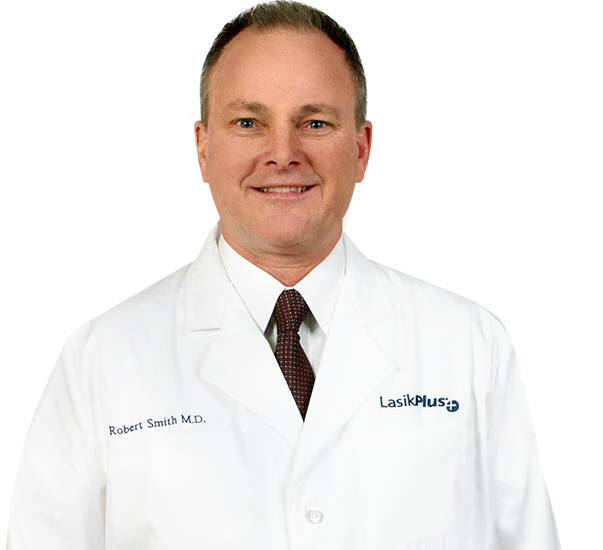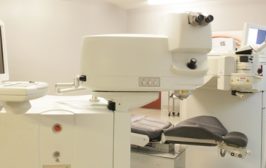-
See the Difference: Save $1,000 on LASIK , Find More
*Must mention this promotion and be treated before April 30 of 2025 to qualify. $1,000 off for both eyes on standard Wavelight price, $500 off for one eye. Cannot be combined with any other offers.
Six Surprising Facts About Laser Eye Surgery
If you are considering getting laser eye surgery, you have likely heard about its potential benefits. However, there are a number of key facts that candidates are surprised to learn when they do their research and undergo the laser eye surgery procedure.
Robert Smith, M.D., a LASIK surgeon based in Dallas, TX, shares six facts that often surprise his patients about getting laser eye surgery.
Fact #1: The Procedure Is Quick and Relatively Pain-Free
Dr. Smith said patients don’t realize how fast and easy the surgery truly is. “Most patients tolerate the surgery extremely well,” he said.
The procedure takes about 15 minutes from start to finish, and the surgeon spends a few minutes on each eye. Dr. Smith also said people are surprised to experience little to no discomfort during the surgery.
Fact #2: LASIK Uses Aerospace Technology
Dr. Smith said patients usually aren’t aware of the technological advances made since LASIK was first introduced.
“Custom LASIK is based on the same technology used in the Hubble Space Telescope project. Additionally, we now have the ability to track eye movement, treat larger areas of the eye and correct higher-order aberrations, which wasn’t necessarily the case with the initial laser platforms,” said Dr. Smith. “The results are sharper vision and less glare and haloes at night.”
Dr. Smith explained that the computerized technology used in LASIK is based off the same technology the United States government uses for missile tracking. Eye function is analyzed, and the data is translated into a customized laser treatment. The eye tracker ensures a more accurate delivery of the laser to ensure a safe procedure.
“Patients don’t need to worry about moving their eyes during the procedure,” Dr. Smith said. “We expect movement during the surgery, and the technology corrects for that.”
Dr. Smith said these advances also mean that if you weren’t a candidate for LASIK in the past, you may be a candidate today. While individual results may vary, more than 90 percent of people who have LASIK achieve between 20/20 and 20/40 vision without needing glasses or contacts.
Fact #3: Patients May See Rapid Improvement
Dr. Smith said patients are often astonished at how rapidly their vision improves.
“I ask my patients to look at a fixation target during the surgery, and the target is blurry,” he said. “I quickly replace the flap, and the target comes into sharp focus. They see a dramatic improvement while still on the table, and when they sit up to get off the bed, many notice they can see the time on the clock across the room.
Vision continues to improve throughout the day, and postoperative care is minimal. Patients should rest the remainder of the day of the procedure. The next day, it is likely they can drive themselves to their follow-up appointment. Restrictions, such as no eye makeup and no touching or rubbing the eyes, are in place the week following the surgery and then are lifted for most patients.
Fact #4: There Are Recreational & Occupational Benefits
Glasses cannot be worn in many active sports, and contacts can be restrictive. Dr. Smith said many patients feel more confident when they are swimming, snorkeling, water skiing, hiking and biking. They are amazed at all they are able to see when participating in activities where glasses or contacts can’t be worn, and they no longer have to worry about glasses sliding down their nose or losing a contact lens.
“There are tangible occupational benefits from the surgery as well,” said Dr. Smith. For example, firefighters are not able to wear glasses or contacts when wearing an oxygen mask. After LASIK, they are able to see things they’ve never seen before when wearing the mask. Additionally, LASIK can help candidates meet vision requirements established by some law enforcement agencies.
Fact #5: LASIK Treats Various Conditions
Glasses and contacts disguise the symptoms of poor vision. LASIK corrects vision issues. The procedure can correct varying levels of myopia (nearsightedness), hyperopia (farsightedness) and astigmatism (irregularly-shaped corneas).
While LASIK can resolve a number of vision issues, the final decision to have the procedure depends on the individual patient’s eyes and personal goals.
“Some patients want their vision corrected so that they are able to participate in activities, such as skiing, without glasses. For other patients, their goal is to reduce their overall dependency on reading glasses for as long as possible,” said Dr. Smith.
An option for patients who want to postpone the need for reading glasses is to have monovision LASIK surgery, as it enables one eye to see more clearly in the distance while the other eye sees better up close.
Fact #6: LASIK Could Save You Money Long Term
According to Dr. Smith, some patients do the math and realize that the money they spend on glasses or contacts ends up being more than the cost of LASIK. Expenses such as new frames, new lenses, replacement lenses and cleaning supplies are all costs that could make LASIK less expensive in the long run than contacts or glasses.
According to Dr. Smith, Abbott Medical Optics Inc. (AMO) conducted a study to determine how much LASIK can save over the cost of contacts. For example, LASIK saves a typical patient between the ages of 40 and 49 approximately $10,000. AMO developed a savings calculator to help candidates estimate the cost effectiveness of LASIK.
Although laser vision correction generally leads to positive, surprising outcomes, individual results will vary. Consult a qualified LASIK provider to find out if the procedure is right for you.
YOU MIGHT ALSO LIKE...
VISION CENTERS NEAR ME
Enter your zip code, city, or a doctor name below to find a vision center.
Find out if LASIK is right for you
Congratulations!
Your vision issues can most likely be corrected with a LASIK procedure. Schedule a free consultation today.
Answer 5 simple questions to see if you are a candidate
What is your age group?
Do you wear...
With corrective lenses, do you have...
Have you ever been told that you have astigmatism?
Have you ever been told that you have dry eyes?
Request an Information Kit
Learn about your surgeon, the latest advanced technology, procedures, options and benefits, financing options, and what to expect from your LASIKPlus experience.









